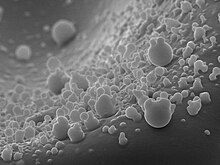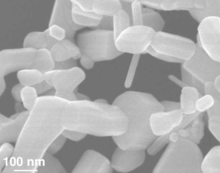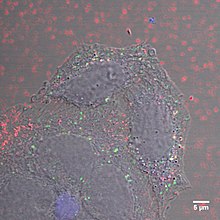Nanochemistry
Nanochemistry is an emerging sub-discipline of the chemical and material sciences that deals with the development of new methods for creating nanoscale materials.[1] The term "nanochemistry" was first used by Ozin in 1992 as 'the uses of chemical synthesis to reproducibly afford nanomaterials from the atom "up", contrary to the nanoengineering and nanophysics approach that operates from the bulk "down"'.[2] Nanochemistry focuses on solid-state chemistry that emphasizes synthesis of building blocks that are dependent on size, surface, shape, and defect properties, rather than the actual production of matter. Atomic and molecular properties mainly deal with the degrees of freedom of atoms in the periodic table. However, nanochemistry introduced other degrees of freedom that controls material's behaviors by transformation into solutions.[3] Nanoscale objects exhibit novel material properties, largely as a consequence of their finite small size. Several chemical modifications on nanometer-scaled structures approve size dependent effects.[2]

Nanochemistry is used in chemical, materials and physical science as well as engineering, biological, and medical applications.
Applications
Medicine
Magnetic Resonance Imaging Detection (MDR)
Over the past two decades, iron oxide nanoparticles for biomedical use had increased dramatically, largely due to its ability of non-invasive imaging, targeting and triggering drug release, or cancer therapy. Stem or immune cell could be marked with iron oxide nanoparticles to be detected by Magnetic resonance imaging (MDR). However, the concentration of iron oxide nanoparticles needs to be high enough to enable the significant detection by MDR.[4] Due to the limited understanding of physicochemical nature of iro oxide nanoparticles in biological systems, more research is needed to ensure nanoparticles can be controlled under certain conditions for medical usage without posing harm to human.[8]
Drug delivery
Emerging methods of drug delivery involving nanotechnological methods can be useful by improving bodily response, specific targeting, and non-toxic metabolism. Many nanotechnological methods and materials can be functionalized for drug delivery. Ideal materials employ a controlled-activation nanomaterial to carry a drug cargo into the body.
The unique structure of carbon nanotubes also gives rise to many innovative inventions of new medical methods. As more medicine is made at the nano level to revolutionize the ways for human to detect and treat diseases, carbon nanotubes become a stronger candidate in new detection methods[12] and therapeutic strategies.[13] Specially, carbon nanotubes can be transformed into sophisticated biomolecule and allow its detection through changes in the carbon nanotube fluorescence spectra.[14] Also, carbon nanotubes can be designed to match the size of small drug and endocitozed by a target cell, hence becoming a delivery agent.[15]
Tissue engineering
Cells are very sensitive to nanotopographical features, so optimization of surfaces in tissue engineering has pushed towards implantation. Under appropriate conditions, a carefully crafted 3-dimensional scaffold is used to direct cell seeds toward artificial organ growth. The 3-D scaffold incorporates various nanoscale factors that control the environment for optimal and appropriate functionality.[16] The scaffold is an analog of the in vivo extracellular matrix in vitro, allowing for successful artificial organ growth by providing the necessary, complex biological factors in vitro.
Wounds healing
For abrasions and wounds, nanochemistry has demonstrated applications in improving the healing process.
Cosmetics


Materials in certain cosmetics such as sun cream, moisturizer, and deodorant may have potential benefits from the use of nanochemistry. Manufacturers are working to increase the effectiveness of various cosmetics by facilitating oil nanoemulsion.
Electrics
Nanowire compositions
Scientists have devised a large number of
Catalysis
Nanoenzymes (or nanozymes)
The small size of nanoenzymes (or nanozymes) (1–100 nm) has provided them with unique optical, magnetic, electronic, and catalytic properties.[25] Moreover, the control of surface functionality of nanoparticles and the predictable nanostructure of these small-sized enzymes have allowed them to create a complex structure on their surface that can meet the needs of specific applications[26]
Research areas
Nanodiamonds
Synthesis
Fluorescent nanoparticles are highly sought after. They have broad applications, but their use in macroscopic arrays allows them efficient in applications of

Fluorescent (nitrogen vacancy)
Drug-delivery and biological compatibility
Nanodiamonds can self-assemble and a wide range of small molecules, proteins antibodies, therapeutics, and nucleic acids can bind to its surface allowing for drug delivery, protein-mimicking, and surgical implants. Other potential biomedical applications are the use of nanodiamonds as support for solid-phase peptide synthesis and as sorbents for detoxification and separation and fluorescent nanodiamonds for biomedical imaging. Nanodiamonds are capable of biocompatibility, the ability to carry a broad range of therapeutics, dispersibility in water and scalability, and the potential for targeted therapy all properties needed for a drug delivery platform. The small size, stable core, rich surface chemistry, ability to self-assemble, and low cytotoxicity of nanodiamonds have led to suggestions that they could be used to mimic globular proteins. Nanodiamonds have been mostly studied as potential injectable therapeutic agents for generalized drug delivery, but it has also been shown that films of Parylene nanodiamond composites can be used for localized sustained release of drugs over periods ranging from two days to one month.[31]
Nanolithography
- Photolithography
- Electron-beam lithography
- X-ray lithography
- Extreme ultraviolet lithography
- Light coupling nanolithography
- Scanning probe microscope
- Nanoimprint lithography
- Dip-Pen nanolithography
- Soft lithography
Each nanolithography technique has varying factors of the resolution, time consumption, and cost. There are three basic methods used by nanolithography. One involves using a resist material that acts as a "mask", known as photoresists, to cover and protect the areas of the surface that are intended to be smooth. The uncovered portions can now be etched away, with the protective material acting as a stencil. The second method involves directly carving the desired pattern. Etching may involve using a beam of


Photoresists
Photoresists are light-sensitive materials, composed of a polymer, a sensitizer, and a solvent. Each element has a particular function. The polymer changes its structure when it is exposed to radiation. The solvent allows the photoresist to be spun and to form thin layers over the wafer surface. Finally, the sensitizer, or inhibitor, controls the photochemical reaction in the polymer phase.[32]
Photoresists can be classified as positive or negative. In positive photoresists, the photochemical reaction that occurs during exposure, weakens the polymer, making it more soluble to the developer so the positive pattern is achieved. Therefore, the masks contains an exact copy of the pattern, which is to remain on the wafer, as a stencil for subsequent processing. In the case of negative photoresists, exposure to light causes the polymerization of the photoresist so the negative resist remains on the surface of the substrate where it is exposed, and the developer solution removes only the unexposed areas. Masks used for negative photoresists contain the inverse or photographic “negative” of the pattern to be transferred. Both negative and positive photoresists have their own advantages. The advantages of negative photoresists are good adhesion to silicon, lower cost, and a shorter processing time. The advantages of positive photoresists are better resolution and thermal stability.[32]
Nanometer-size clusters
Monodisperse, nanometer-size clusters (also known as
Interest in the magnetic properties of nanoclusters exists due to their potential use in
Dielectric properties of nanoclusters are also a subject of interest due to their possible applications in catalysis, photocatalysis, micro capacitors, microelectronics, and nonlinear optics.[34]
Nanothermodynamics
The idea of nanothermodynamics was initially proposed by T. L. Hill in 1960, theorizing the differences between differential and integral forms of properties due to small sizes. The size, shape, and environment of a nanoparticle affect the power law, or its proportionality, between nano and macroscopic properties. Transitioning from macro to nano changes the proportionality from exponential to power.[35] Therefore, nanothermodynamics and the theory of statistical mechanics are related in concept.[36]
Notable researchers
There are several researchers in nanochemistry that have been credited with the development of the field. Geoffrey A. Ozin, from the University of Toronto, is known as one of the "founding fathers of Nanochemistry" due to his four and a half decades of research on this subject.[37] This research includes the study of matrix isolation laser Raman spectroscopy, naked metal clusters chemistry and photochemistry, nanoporous materials, hybrid nanomaterials, mesoscopic materials, and ultrathin inorganic nanowires.[38]
Another chemist who is also viewed as one of the nanochemistry's pioneers is Charles M. Lieber at Harvard University. He is known for his contributions to the development of nano-scale technologies, particularly in the field of biology and medicine.[39] The technologies include nanowires, a new class of quasi-one-dimensional materials that have demonstrated superior electrical, optical, mechanical, and thermal properties and can be used potentially as biological sensors. Research under Lieber has delved into the use of nanowires mapping brain activity.[40]
Shimon Weiss, a professor at the University of California, Los Angeles, is known for his research of fluorescent semiconductor nanocrystals, a subclass of quantum dots, for biological labeling.[41]
Paul Alivisatos, from the University of California, Berkeley, is also notable for his research on the fabrication and use of nanocrystals. This research has the potential to develop insight into the mechanisms of small-scale particles such as the process of nucleation, cation exchange, and branching. A notable application of these crystals is the development of quantum dots.[42]
Peidong Yang, another researcher from the University of California, Berkeley, is also notable for his contributions to the development of 1-dimensional nanostructures. The Yang group has active research projects in the areas of nanowire photonics, nanowire-based solar cells, nanowires for solar to fuel conversion, nanowire thermoelectrics, nanowire-cell interface, nanocrystal catalysis, nanotube nanofluidics, and plasmonics.[43]
References
- ISBN 978-0-08-100907-9, retrieved 2022-10-28
- ^ ISSN 0935-9648.
- ISBN 978-3527325979.
- ^ PMID 22568907, retrieved 2022-10-28
- ^ "Nanotechnology | National Geographic Society". education.nationalgeographic.org. Retrieved 2022-10-28.
- PMID 19914316.
- PMID 22093220, retrieved 2022-10-28
- S2CID 137339611.
- PMID 26258053.
- PMID 22540671.
- PMID 24647752.
- PMID 21258331.
- PMID 28212271.
- PMID 16522025.
- S2CID 30926622.
- PMID 20726522.
- ^ Kingshott, Peter. "Electrospun nanofibers as dressings for chronic wound care" (PDF). Materials Views. Macromolecular Bioscience.
- PMID 30288038.
- PMID 21945220.
- PMID 31799232.
- PMID 22923959.
- ^ "Uses of nanoparticles of titanium(IV) oxide (titanium dioxide, TiO2)". Doc Brown's Chemistry Revision Notes – Nanochemistry.
- ISBN 978-3-642-22236-8.
- S2CID 4283353.
- PMID 23740388.
- ^ Aravamudhan, Shyam (2007). Development of Micro/Nanosensor elements and packaging techniques for oceanography (Thesis). University of South Florida.
- S2CID 46588525.
- LCCN 2018021226.
- ^ Hinman, Jordan (October 28, 2014). "Fluorescent Diamonds" (PDF). University of Illinois at Urbana–Champaign.
- PMID 16351080.
- PMID 22179567.
- ^ ISBN 978-0-08-102055-5, retrieved 2022-11-14
- ^ a b c Wilcoxon, J.P. (October 1995). "Fundamental Science of Nanometer-Size Clusters" (PDF). Sandia National Laboratories.
- PMID 31458007.
- S2CID 210794644.
- PMID 23449763.
- ^ "Father of nanochemistry – U of T's Geoffrey Ozin recognized for contributions to energy technology". University of Toronto News. Retrieved 2022-11-14.
- ^ Ozin, Geoffrey (2014). Nanochemistry Views. Toronto. p. 3.
{{cite book}}: CS1 maint: location missing publisher (link) - ^ "Intellectual, innovator, and educator". chemistry.harvard.edu. Retrieved 2022-11-14.
- ^ Lin Wang, Zhong (2003). Nanowires and Nanobelts: Materials, Properties, and Devices: Volume 2: Nanowires and Nanobelts of Functional Materials. New York, N.Y.: Springer. pp. ix.
- ^ "Shimon Weiss – Molecular Biology Institute". 28 August 2015. Retrieved 2022-11-14.
- ^ "Paul Alivisatos | University of Chicago Department of Chemistry". chemistry.uchicago.edu. Retrieved 2022-11-14.
- ^ "Summary of Research Interests – Peidong Yang Group". Retrieved 2022-11-14.
Selected books
- J.W. Steed, D.R. Turner, K. Wallace Core Concepts in Supramolecular Chemistry and Nanochemistry (Wiley, 2007) 315p. ISBN 978-0-470-85867-7
- Brechignac C., Houdy P., Lahmani M. (Eds.) Nanomaterials and Nanochemistry (Springer, 2007) 748p. ISBN 978-3-540-72993-8
- H. Watarai, N. Teramae, T. Sawada Interfacial Nanochemistry: Molecular Science and Engineering at Liquid-Liquid Interfaces (Nanostructure Science and Technology) 2005. 321p. ISBN 978-0-387-27541-3
- Ozin G., Arsenault A.C., Cademartiri L. Nanochemistry: A Chemical Approach to Nanomaterials 2nd Eds. (ISBN 978-1847558954
- Kenneth J. Klabunde; Ryan M. Richards, eds. (2009). Nanoscale Materials in Chemistry (2nd ed.). Wiley. ISBN 978-0-470-22270-6.
